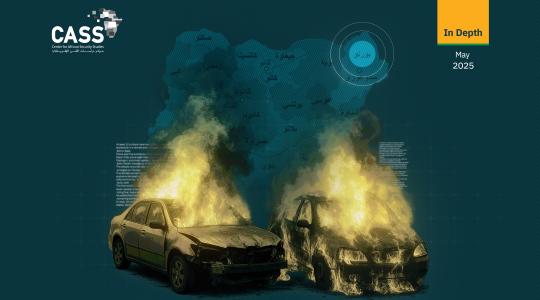On June 20, 2024, Islamic State group fighters slaughtered 22 civilians in the Ituri region of the eastern Congo. The attack was the latest in a string of more than 130 deadly assaults on Christian civilians in the eastern Democratic Republic of Congo since the start of the year, which have killed at least 800 civilians.
The campaign constitutes a clear escalation by the group, which in one operation killed 60 civilians and burned down the entire village of Masala, in the Beni region.
Since 2020, IS attacks in North Kivu and South Kivu provinces have displaced of hundreds of thousands of civilians. They include some 60,000 civilians between April and June this year alone. The group’s “Central Africa Province” now controls large areas of both provinces, particularly the Beni, Ituri and Lubero regions near the Ugandan border.
Explaining the Rise of IS in the DRC
The so-called “Central Africa Province” of IS has its roots in the Allied Democratic Forces (ADF), a Ugandan rebel group formed in 1995 with the aim of overthrowing the government in Kampala. Under pressure from the Ugandan military, the group was forced to seek refuge in eastern Congo, particularly the isolated areas of Beni and Ituri.
The ADF publicly declared allegiance to IS in 2018, changing its name to the “Central Africa Province” of IS. However, the group had already quietly pledged its loyalty to the jihadist organization two years earlier, in 2016, and the following July IS sent it some $200,000 via Bilal al-Sudani (also known as Suhayl Salim Abd el-Rahman), a former Shabaab militant who was assassinated by the United States in January last year.
IS forces in Uganda are led by a former ADF commander, Mohamed Ali Nkalubo, who is deputy to the current head of the ADF, Seka Musa Baluku, who IS appointed as governor of its new “province.”
Both men have played direct roles in consolidating IS’s presence in western Uganda, including Kasese district and the Queen Elizabeth National Park near the border with the DRC, as well as the Beni, Ituri, and Lubero regions in North Kivu and South Kivu provinces on the western side of the frontier.
The turning point in the organization’s rise came in October 2020, when it stormed Kangbayi prison in Beni Province, freeing more than 1,300 mainly Salafist prisoners who went on to join IS ranks. The group was also supported by the arrival of IS administrative and military figures who had fought in Iraq and Syria. Over the course of 2023, judges, sharia experts, and military trainers from Libya, Yemen, Iraq, Syria, and the Sahel region all flocked to eastern DRC to develop a strategy to seize more territory across the region.
Purging Civilians, Seizing Territory
IS began stepping up its attacks against Christian civilians in the Congo in January 2018, and it has gradually escalated its assaults ever since, carrying out around 1,000 attacks over the course of 2023.
Throughout its campaign, it has used a number of tactics: large-scale direct attacks on government military positions, bombings with improvised explosive devices (IEDs), large-scale massacres and ethnic cleansing, and the sabotage of government and civilian property. It also exploits the region’s forested terrain in order to hide and move about.
The group has played on sectarian and ethnic tensions as part of a strategy to destabilize the region and undermine the security situation. Since the start of 2024, its attacks in North and South Kivu provinces have left at least 800 civilians and 70 members of the Congolese forces dead, as well as displacing tens of thousands of people.
An analysis of the group’s activities in the DRC reveals a clear focus on targeting civilians, pushing them to flee en masse, while it has carried out relatively few attacks on the army. The group has sowed fear among the civilian population, with 51 separate massacres, 34 mass kidnappings and 22 arson attacks that have burned down hundreds of homes in villages throughout the region.
Seeking to Expand
As it extends its control over ever more territory, IS has been able to reap bigger financial rewards from the resources it seizes. These include forests, whose wood it can sell through Chinese timber companies operating in the DRC, and pastoral land, control of which allows the organization to impose new taxes on local livestock herders. This income further bolsters its capacity to seize yet more territory, giving it a greater freedom of movement and allowing it to avoid being cornered into a small area.
Such freedom of movement may also allow IS to expand towards and across the borders with neighboring Uganda and Rwanda, meaning it could establish a permanent presence in these two countries in the near future. This hypothesis is strengthened by the group’s attacks on a high school and a church on the Ugandan side of the border in June 2023, as well as its May 2024 seizure of the town of Shasha, on the Goma-Bukavu highway that runs along the western bank of Lake Kivu, near the Rwandan border.
By attacking villages and towns across swathes of the Ituri, Beni and Lubero regions, IS is seeking to expand its area of control through a strategy of gradual expansion. It first imposes its influence through “taxes” on livestock, crops, and transportation, then by seizing territory and displacing the population. This mass internal displacement of civilians could lead to a security vacuum in the region and place pressure on the government to provide shelter and basic food supplies. That is a tall order in a country with some six million internally displaced people, one of the biggest such populations in the world.




